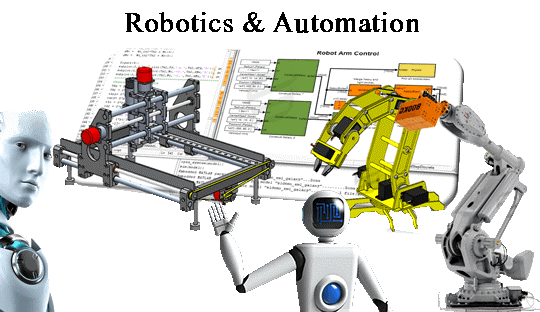
Robotics and Automation
Advances in Robotics and Automation: A Glimpse into Tomorrow’s World
Are you ready to step into tomorrow’s world? A world where robots go beyond the realm of science fiction and become an integral part of our everyday lives? From self-driving cars to robotic surgeries, the incredible advances in robotics and automation are revolutionizing industries and reshaping how we live and work.
In this article, we will take an exciting journey into the future and explore the remarkable breakthroughs in robotics and automation. Witness firsthand how robots are designed to perform complex tasks, enhancing efficiency, precision, and safety. Discover how automation streamlines processes, freeing up human potential for innovation and creativity.
With the rapid pace of technological advancements, the possibilities seem endless. Integrating artificial intelligence, machine learning, and robotic capabilities offers a glimpse into a future where robots become our companions, helping us in ways we never imagined possible.
Join us as we navigate through this ever-evolving landscape of robotics and automation, uncovering the unlimited potential that lies ahead. Let’s embark on this adventure to explore the future, where humans and robots coexist, transforming how we interact with the world around us.
The evolution of robotics and automation:
The concept of automation dates back to the Industrial Revolution in the late 18th century when machines replaced human labor in manufacturing. However, it wasn’t until the mid-20th century that robots were introduced in factories, performing repetitive tasks more accurately and efficiently than humans.
Over the years, robotics has evolved to incorporate advanced sensors, actuators, and control systems that enable robots to perform complex tasks such as welding, painting, and assembly. Today, robots use various industries, from automotive and aerospace to healthcare and logistics.
Automation has also undergone significant changes with the advent of computer-based systems that can perform repetitive tasks with minimal human intervention. This has led to the development of automated assembly lines, data entry systems, and even self-driving cars.
Applications of robotics and automation in various industries:
One of the most significant areas where robotics and automation have significantly impacted is the manufacturing industry. Robots are used to perform tasks such as welding, painting, and assembly, which require high precision and speed. This has led to increased efficiency, reduced costs, and improved product quality.
In the healthcare industry, robots are being used to perform surgeries with greater precision and accuracy than human surgeons. This has led to reduced risk and faster recovery times for patients. Robots are also being used to assist patients with mobility issues, helping them move around and perform daily tasks.
In the logistics industry, robots are being used to automate tasks such as packing, sorting, and transportation. This has led to faster delivery times, improved accuracy, and reduced costs.
Advantages of robotics and automation:
One of the primary advantages of robotics and automation is increased efficiency. Robots can perform tasks faster and more accurately than humans, improving productivity and reducing costs.
Automation also frees up human potential for innovation and creativity. By automating repetitive tasks, humans can focus on more complex and creative tasks that require critical thinking and problem-solving skills.
In businesses where human workers can face dangerous conditions or do jobs that demand high precision, robots also offers increased safety. Robots can perform jobs, for instance, in the mining sector to explore and extract minerals from hazardous regions.
Current advancements in robotics and automation:
Integrating artificial intelligence and machine learning has led to significant advancements in robotics and automation. Robots can now learn from their surroundings and adapt to changing conditions, making them more versatile and efficient.
One of the most exciting development areas is soft robotics, where robots are made from materials that mimic the flexibility and adaptability of biological organisms. These robots can be used in various applications, from medical implants to search and rescue missions.
Another area of development is in the field of collaborative robotics, where robots work alongside humans to perform tasks. This has led to increased efficiency and improved safety, as robots can perform tasks that are too dangerous for humans.
Artificial intelligence and machine learning in robotics and automation:
Artificial intelligence and machine learning are key components in developing advanced robotics and automation systems. These technologies enable robots to learn from their environment, make decisions, and adapt to changing conditions.
Machine learning algorithms train robots to recognize patterns and make predictions based on data. This enables robots to perform tasks with greater accuracy and efficiency.
Artificial intelligence develops robots that can interact with humans in a more natural way. These robots can understand and respond to human speech and gestures, making them more intuitive to use.
Future prospects and potential impact of robotics and automation:
The future of robotics and automation is exciting, with endless possibilities for innovation and development. With the integration of artificial intelligence and machine learning, robots will become even more versatile and efficient, transforming the way we live and work.
Robots uses in variety of applications, from healthcare and education to agriculture and space exploration. They will help us perform tasks that are too dangerous, time-consuming, or physically challenging for humans.
The impact of robotics and automation will be significant, with increased efficiency, reduced costs, and improved safety. However, challenges and ethical considerations will also exist, such as job displacement and privacy concerns.
Challenges and ethical considerations in robotics and automation:
One of the main challenges of robotics and automation is job displacement. As robots become more efficient and versatile, they will replace human workers in many industries, leading to job losses and economic disruption.
There are also ethical considerations, such as using robots in military applications, which raises questions about the morality of autonomous weapons. There are also concerns about privacy and data protection, as robots collect and analyze vast amounts of data about human behaviour.
Industries that will benefit the most from robotics and automation:
The industries that will benefit the most from robotics and automation are those that require high precision and speed, or those that involve hazardous conditions. Some industries already using robotics and automation include manufacturing, healthcare, logistics, and mining.
However, as technology advances, it is likely that other industries will also adopt robotics and automation, leading to increased efficiency and productivity.
Conclusion:
In conclusion, the incredible advances in robotics and automation are revolutionizing industries and reshaping how we live and work. With the integration of artificial intelligence and machine learning, robots will become even more versatile and efficient, transforming how we interact with the world around us.
While there are challenges and ethical considerations, the benefits of robotics and automation are significant, with increased efficiency, reduced costs, and improved safety. It is up to us to embrace this future and ensure that we use this technology in a responsible and ethical way. Let’s step into tomorrow’s world and explore the unlimited potential that lies ahead.
